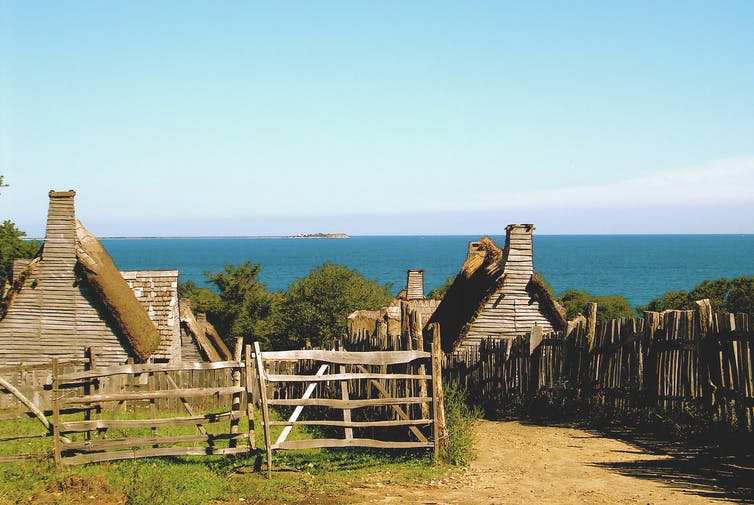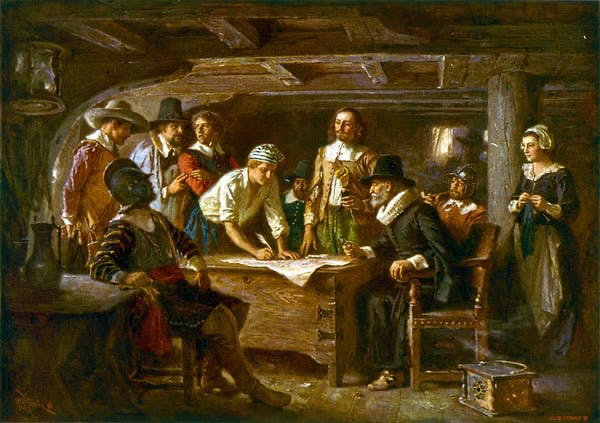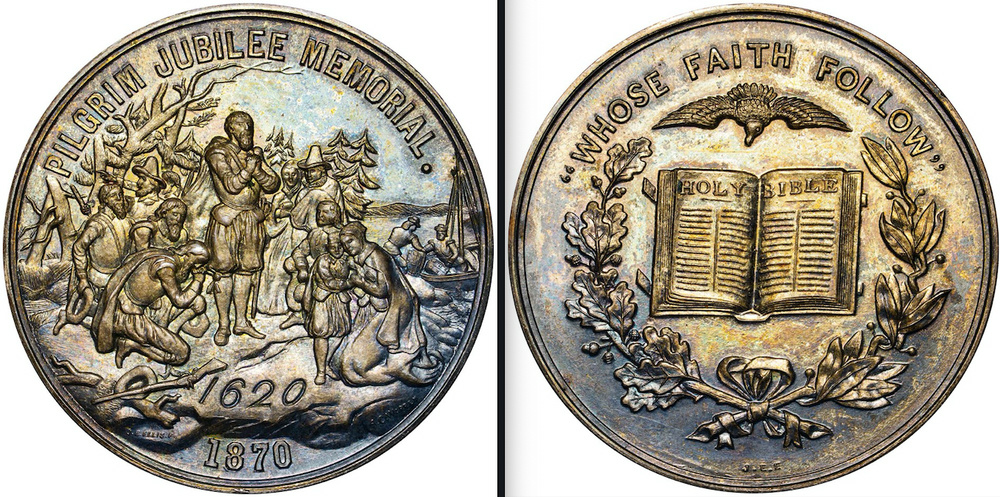
In an article first published on The Conversation, US academic PETER C MANCALL looks at why the Pilgrim’s voyage to Plymouth has such a prominent place in the story of America…
The 400th anniversary of the Pilgrims’ voyage to Plymouth will be celebrated on both sides of the Atlantic with a “remembrance ceremony” with state and local officials and a museum exhibit in Plymouth, England. IBM has even outfitted a replica of the Mayflower with an AI navigating system that will allow the ship to trace the course of the original journey without any humans on board.
Yet as a scholar of early 17th-century New England, I’ve always been puzzled by the glory heaped on the Pilgrims and their settlement in Plymouth.

Plimoth Plantation, in Plymouth, Massachusetts, is a living museum that’s a replica of the original settlement, which existed for 70 years. PICTURE: Wikimedia Commons (licensed under CC BY-SA)
Native Americans had met Europeans in scores of places before 1620, so yet another encounter was hardly unique. Relative to other settlements, the colony attracted few migrants. And it lasted only 70 years.
So why does it have such a prominent place in the story of America? And why, until recently, did the more troubling aspects to Plymouth and its founding document, the Mayflower Compact, go ignored?
“Why does it have such a prominent place in the story of America? And why, until recently, did the more troubling aspects to Plymouth and its founding document, the Mayflower Compact, go ignored?”
Prophets and profits
The establishment of Plymouth did not occur in a vacuum.
The Pilgrims’ decision to go to North America – and their deep attachment to their faith – was an outcome of the intense religious conflict roiling Europe after the Protestant Reformation. Shortly before the travelers’ arrival, the Wampanoag residents of Patuxet – the area in and around modern day Plymouth – had suffered a devastating, three-year epidemic, possibly caused by leptospirosis, a bacterial disease that can lead to meningitis, respiratory distress and liver failure.
It was during these two crises that the histories of western Europe and Indigenous North America collided on the shores of Massachusetts Bay.
Despite a number of advantages, including less competition for local resources because of the epidemic, Plymouth attracted far fewer English migrants than Virginia, which was settled in 1607, and Massachusetts, which was established in 1630.
The Pilgrims, as they told their story travelled so they could practice their religion free from persecution. But other English joined them, including some migrants seeking profits instead of heeding prophets. Unfortunately for those hoping to earn a quick buck, the colony never became an economic dynamo.
A shaky compact
Plymouth nonetheless went on to attain a prominent place in the history of America, primarily due to two phenomena: It was the alleged site of the first Thanksgiving, and its founders drafted the Mayflower Compact, a 200-word document written and signed by 41 men on the ship.
Generations of American students have learned that the Compact was a stepping stone towards self-government, the defining feature of American constitutional democracy.
But did Plymouth really inspire democracy? After all, self-governing communities existed across Indigenous New England long before European migrants arrived. And a year earlier, in 1619, English colonists in Virginia had created the House of Burgesses to advance self-rule in North America for subjects of King James I.
So American self-government, however one defines it, was not born in Plymouth.
The Mayflower Compact nonetheless contained lofty ideals. The plan signed by many of the Mayflower’s male passengers demanded that colonists “Covenant & Combine ourselves into a Civil body politic, for our better ordering, & preservation.” They promised to work together to write “laws, ordinances, Acts, constitutions.” The signers pledged to work for the “advancement of the Christian faith”.

Jean Leon Gerome Ferris’ ‘The Mayflower Compact, 1620′. PICTURE: Library of Congress
Yet as the years after 1620 bore out, the migrants did not adhere to such principles when dealing with their Wampanoag and other Algonquian-speaking neighbors. Gov. William Bradford, who began writing his history of Plymouth in 1630, wrote about the Pilgrims arriving in “a hideous and desolate wilderness, full of wild beasts and wild men” even though Patuxet looked more like a settled European farmland. The Pilgrims exiled an English lawyer named Thomas Morton, in part because he believed that Indigenous and colonists could peacefully coexist. And in 1637, Plymouth’s authorities joined a bloody campaign against the Pequots, which led to the massacre of Indigenous people on the banks of the Mystic River, followed by the sale of prisoners into slavery.
The Compact was even used by loyalists to the British crown to argue against independence. Thomas Hutchinson, the last royal governor of Massachusetts, pointed to the Pilgrims as proof that colonists should not rebel, highlighting the passage that defined the signers as “loyal subjects” of the English king.
History told by the victors
After the American Revolution, politicians and historians, especially those descended from Pilgrims and Puritans, were keen to trace the origins of the United States back to Plymouth.
In the process, they glossed over the Pilgrims’ complicated legacy.
In 1802, the future President John Quincy Adams spoke at Plymouth about the unique genius of the colony’s founders and their governing contract. He announced that the Pilgrims would arrive at the Biblical day of judgment “in the whiteness of innocence” for having shown “kindness and equity toward the savages.”
In the mid-19th century, the historian George Bancroft claimed that it was in “the cabin of the Mayflower” where “humanity recovered its rights, and instituted government on the basis of ‘equal laws’ for ‘the general good.’”
Nineteenth-century anniversary celebrations focused on the colonists, their written Compact, and their contribution to what became the United States. In 1870, on the 250th anniversary, celebrants struck a commemorative coin: one side featured an open Bible, the other a group of Pilgrims praying on the shoreline.
Missing, not surprisingly, were the Wampanoags.

A coin honouring the 250th anniversary of the Pilgrims landing in Plymouth. PICTURE: NGC Coin
A more nuanced view of the past
By 1970, the cultural tide had turned. Representatives of the Wampanoag nation walked out of Plymouth’s public celebration of Thanksgiving that year to announce that the fourth Thursday in November should instead be known as the National Day of Mourning. To these protesters, 1620 represented violent conquest and dispossession, the twinned legacies of exclusion.
The organizers of an international group called “Plymouth 400” have stressed that they want to tell a “historically accurate and culturally inclusive history.” They’ve promoted both the General Society of Mayflower Descendants and an exhibit featuring 400 years of Wampanoag History. Unlike earlier generations of celebrants, the organisers have acknowledged the continued presence of Native residents.
Prior celebrations of Plymouth’s founding focused on the Pilgrims’ role in the creation of the United States. By doing so, these commemorations sustained an exclusionary narrative for over two centuries.
Perhaps this year a different story will take hold, replacing ancestor worship with a more clear-eyed view of the past.
Peter C Mancall is the Andrew W Mellon Professor of the Humanities at the University of Southern California – Dornsife College of Letters, Arts and Sciences. This article is republished from The Conversation under a Creative Commons license. Read the original article.





